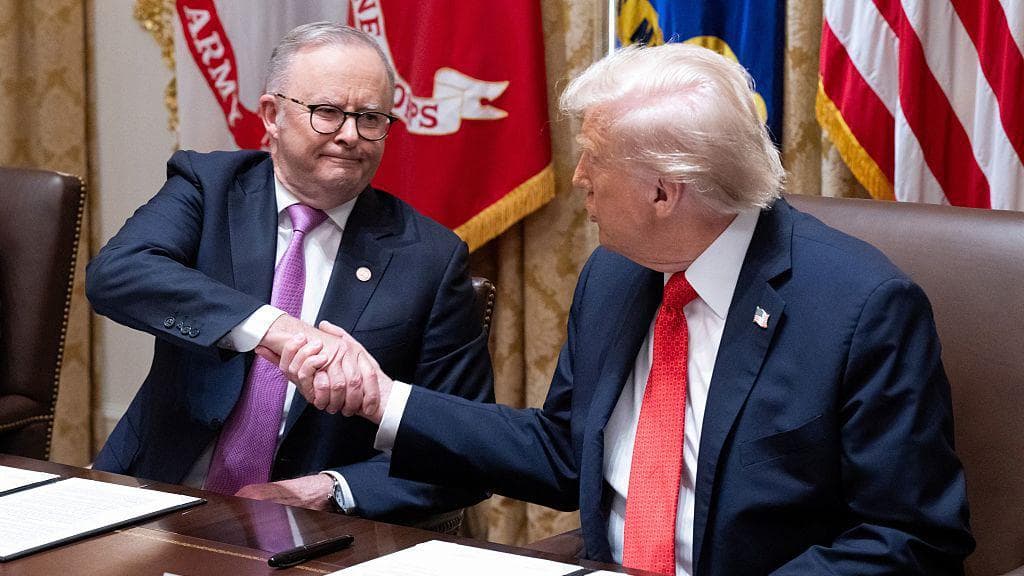Loading News Article...
We're loading the full news article for you. This includes the article content, images, author information, and related articles.
We're loading the full news article for you. This includes the article content, images, author information, and related articles.
A new critical minerals deal between the United States and Australia aims to diversify the global supply chain for rare earth elements, vital for modern technology and defence, a move with potential implications for emerging producers like Kenya.

The United States and Australia have formally signed an agreement to bolster the supply of rare earth elements and other critical minerals, seeking to reduce reliance on China, which currently dominates the global market. The deal, announced on Monday, October 20, 2025, by US President Donald Trump and Australian Prime Minister Anthony Albanese, involves a pipeline of projects valued at $8.5 billion (approximately KSh 1.2 trillion) aimed at expanding mining and processing capabilities in both nations.
This strategic partnership includes an immediate investment of $1 billion (approximately KSh 140 billion) from both countries into joint projects over the next six months. The collaboration seeks to establish alternative production centres in politically stable jurisdictions, mitigating vulnerabilities in existing supply chains, particularly for materials crucial to defence, technology, and renewable energy sectors.
China currently holds a significant lead in the rare earth industry, controlling approximately 69-70% of global rare earth mining and an overwhelming 85-90% of processing capacity. This dominance extends to the production of rare earth permanent magnets, with Chinese facilities accounting for over 90% globally. Rare earth elements, a group of 17 metallic elements, are indispensable for a wide array of modern technologies, including smartphones, electric vehicles, wind turbines, and advanced defence systems.
Beijing's strategic investments over decades, coupled with historically lenient environmental policies, have allowed it to undercut competitors on cost and scale. China has also demonstrated a willingness to use rare earth exports as a policy tool, as seen during a 2010 diplomatic crisis with Japan when export quotas were reduced, causing prices to surge. More recently, China implemented new export controls on rare earth processing technology in December 2023, requiring licenses for magnet manufacturing equipment exports.
Kenya possesses substantial, largely untapped deposits of rare earth elements, particularly at Mrima Hill in Kwale County. These deposits are estimated to be worth $62.4 billion (approximately KSh 8.7 trillion), placing Mrima Hill among the top five rare earth deposits globally. The area also contains niobium deposits valued at an estimated $35 billion (approximately KSh 4.9 trillion), a critical material for high-strength steel used in aerospace, automotive, and construction industries.
Despite these significant reserves, Kenya's rare earth minerals have remained largely unexploited for over a century. The Kenyan government aims to increase the mining sector's contribution to the Gross Domestic Product (GDP) from less than 1% to 10% by 2030, with rare earth elements identified as a key resource for achieving this goal.
Kenya's Mining and Minerals Policy (2016) and the Mining Act (2016) aim to create a conducive environment for investment and ensure the country benefits maximally from its mineral wealth. The Constitution of Kenya (2010) mandates parliamentary ratification for any transaction involving the exploitation of natural resources, ensuring transparency and accountability.
In December 2019, the government imposed a moratorium on processing and issuing new mining licenses, which was partially lifted in October 2023 for construction and industrial minerals. All other minerals, including rare earths, have been classified as strategic minerals, with the National Mining Corporation (NMC) holding exclusive oversight for their extraction.
Australian mining companies RareX and Iluka Resources have jointly applied for a permit to prospect rare earth deposits in Kwale County, specifically eyeing the Mrima Hill area. RareX Managing Director James Durrant stated that the company plans to leverage Iluka's expertise and resources to create a major, multi-commodity project in Kenya, integrating the rare earths component with an Australian government-backed value chain.
Veronica Bolton Smith, CEO of the Critical Minerals Africa Group, noted in April 2025 that Kenya is taking significant steps to position itself as a key player in the global critical minerals sector. She emphasised the group's interest in exploring how they can help unlock investment to support Kenya's development goals and the broader energy transition in Africa.
The global push to diversify rare earth supply chains presents a significant opportunity for Kenya to attract foreign investment and develop its mining sector. However, challenges remain, including the complex and costly nature of rare earth extraction and processing, as these elements often exist in low concentrations and require advanced separation techniques.
Past legal disputes, such as the 2013 revocation of a mining license for Cortec Mining Kenya Limited at Mrima Hill, have raised concerns among investors about resource nationalism. Ensuring sustainable mining practices and equitable benefit-sharing with local communities will be crucial for the long-term success of Kenya's rare earth industry.
The progress of the US-Australia critical minerals pact and its impact on global rare earth prices and supply chain dynamics will be closely watched. For Kenya, key developments will include the government's ongoing ground-truthing and confirmatory fieldwork to validate the National Airborne Geophysical Survey (NAGS) findings, which identified 970 mineral occurrences across the country. Decisions regarding the applications from companies like RareX and Iluka Resources for prospecting permits in Kwale County will also be significant indicators of Kenya's readiness to attract and facilitate foreign investment in its strategic mineral sector.
Keep the conversation in one place—threads here stay linked to the story and in the forums.
Other hot threads
E-sports and Gaming Community in Kenya
Active 6 months ago
Popular Recreational Activities Across Counties
Active 6 months ago
The Role of Technology in Modern Agriculture (AgriTech)
Active 6 months ago
Investing in Youth Sports Development Programs
Active 6 months ago